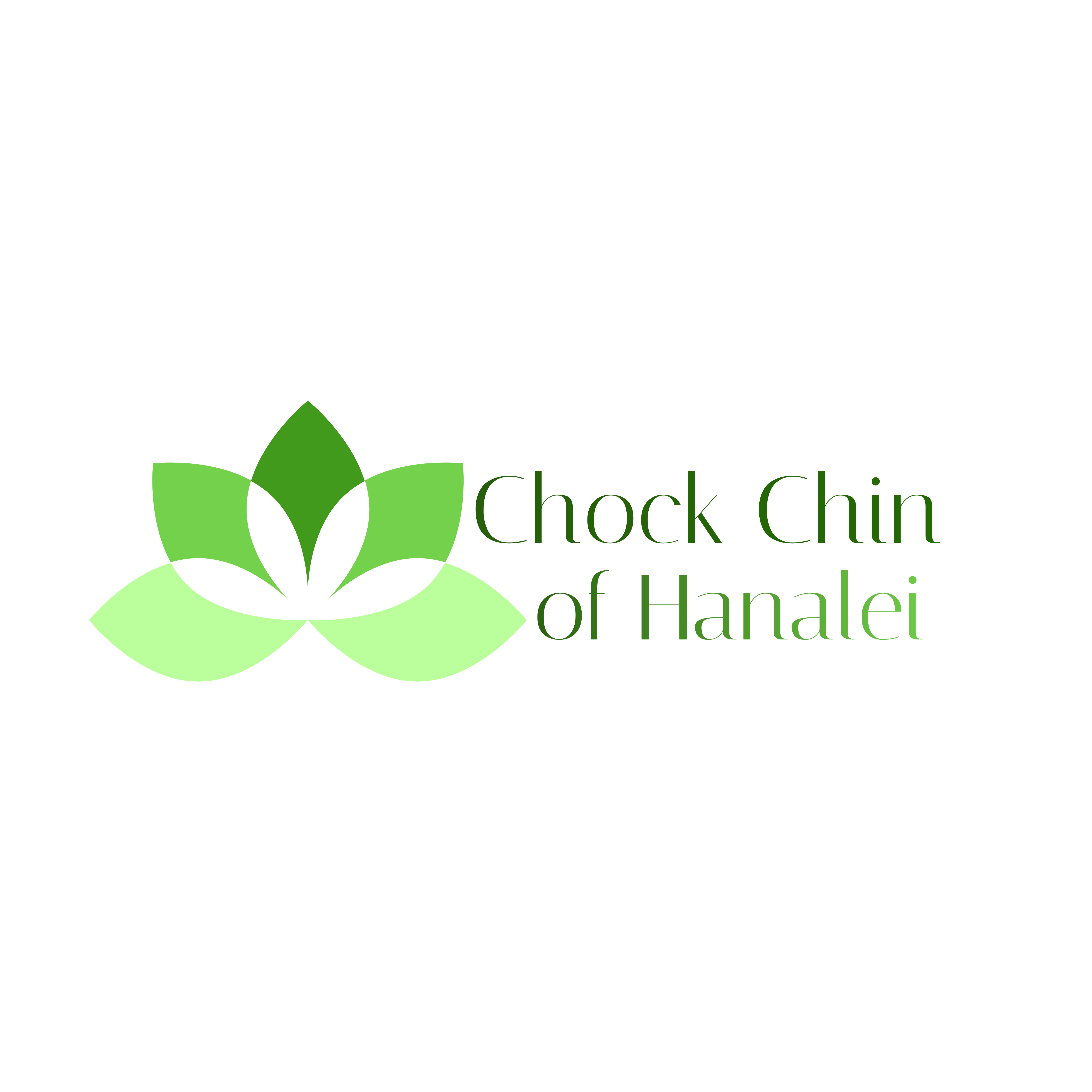In March of 2021, we expanded the scope of our research to include searching for the families of the women who married into the Chock clan. This is very difficult to do, because the information about females recorded in clan records is usually very brief (surname only, like Miss Chock). No parent’s names or birthplaces are typically noted for the wives when they are added to the records of the Chock men.
Despite the challenges, Louise agreed to start looking for any females in the Chock records who did have information listed about their father sufficient to go find the father’s clan jiapu. The first one she spotted was my 2nd great-grandmother Miss Gu古, whose father was noted in the Chock/Zhuo jiapu as Gu Lue-Shen古畧深 of Nazhou 那洲 Village. She now needed to go consult the Nazhou Gu jiapu to try to find Gu Lue-Shen’s name and thereby identify his position in the family pedigree.
She had already found the 1912 Nazhou Gu jiapu in the digital collections at Family Search and had reviewed it carefully. However, with the new mission of finding the fathers of the women who married into the Chock family, she decided to reread it with even greater care.
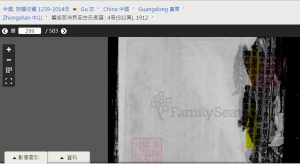
Torn pages in 1912 Nazhou Gu Jiapu
Unfortunately, she found that there were a number of pages that had been partially ripped or torn from the jiapu before it had been microfilmed and uploaded to Family Search. As luck would have it, one of the missing pages was exactly where Louise expect to find Gu Lue-Shen in the family record.
Based on her years of experience with these kinds of records, she felt strongly that Gu Lue Shen’s name was on one of those missing pages.
After deep consideration, even without actually seeing Gu Lue Shen’s name in the jiapu, she went ahead and added him as the father of my ancestor, Miss Gu, and linked his family tree together within familysearch.org.
Bits and pieces of this tree had been submitted by several people in different sections over the years, leaving duplicate profiles and a lot of disconnected pieces. She used what was available in the record and her professional experience to map the family tree together from the disparate parts. But as confident as she was, she still wished that somewhere there would be another copy of the record that had not been damaged, and she could see Gu Lue Shen’s name on it.
Not the only one looking for Gu Lue Shen
At the same time Louise was entering Gu Lue Shen’s information into family search, a Mr. Gu living in southeast China was searching for information about the relatives of Gu Chuan Wei, who had been a famous artist in China, and just happened to be the nephew of Gu Lue Shen.
This was no idle search, but an important research project for his clan association. It was prompted by the descendants of the artist who were trying to find out what had happened to the relatives who had emigrated to Hawaii when he was a young boy. At the time they left, Gu Chuan Wei’s artistic talent was just beginning to blossom and gain recognition. The young artist didn’t want to leave China and interrupt his training. His relatives who were fleeing China promised to support him when they found work in Hawaii.
True to their promise, they supported him for many years by sending money to him from Hawaii. He and his children believed this had saved his life during this period of famine and poverty in China. And now, in 2021, his descendants approached the clan and asked for help to find the descendants of these relatives in Hawaii, so they could honor and thank them for saving their father’s life so he could go on to contribute great art.
Harder than it looks to find Chinese immigrants
It is incredibly hard for Chinese researchers to locate descendants of Chinese clans in Hawaii for some fundamental reasons. Mr. Gu ran into all of these problems, in addition to the fact that the jiapu had torn pages.
First, records kept in Hawaii do not typically record Chinese names using Chinese characters, called Hanzi (“Han characters”). Instead, names are written phonetically using the English alphabet, rather arbitrarily depending on the person writing the record. This created Romanized versions of these names that were spelled the way they sounded to the census taker, ship’s steward, plantation manager, etc. Thus, on the spot, with the stroke of a pen, a stranger determines the name a person and his family will use forever after.
Second, a phonetic spelling is, by definition, going to vary depending on how a person pronounces their name. A clan name rendered in Hanzi always looks the same no matter how you say it. But a Cantonese speaker from Guangdong province will say that name very differently from a Mandarin speaker born in a different part of China. (My surname sounds like Chock in Cantonese, and Zhuo in Mandarin.)
There are 10 official variants of Chinese, which all use the same writing system (the same Hanzi characters) but sound vastly different. So a man who speaks Cantonese will say his name to the guy with the pen in a completely different way than a fellow clan member who speaks Mandarin or one of the other variants. And the guy with the pen will write it the way it sounds to him.
Third, the same family living in different households, and reporting every ten years to census takers, may easily have their surname spelled in a dizzying number of variant spellings. (I have census records that list my surname as Chok, Chuck, Cheuk, Chook, and Cho. All depended on the ear of the census taker.) So trying to locate records of the same family in different years and types of records can be a merry chase through mismatched names.
And fourth, even with good English language skills, Chinese researchers usually struggle to interpret cursive script. Particularly with the many stylistic variations, and ornate flourishes that are often seen on important documents like marriage certificates, legal contracts, and birth certificates in the 19th and 20th century.
Desperate enough to Google
Although Mr. Gu worked at the Zhuhai Museum and was an experienced researcher, he had never used familysearch.org to research (it is not available within mainland China). But at this point he had exhausted every other archive and repository he could find within China, so he found a way to conduct a somewhat illicit Google search (banned in mainland China) — perhaps from a nearby country.
Google dutifully pulled up the newly added record of Gu Lue Shen that Louise had just added as my 16th ancestor. This was literally the only place on the internet where that name could be found.

Mr Gu contacts Susan on Family Search
Mr. Gu was astonished to find him on a Western website. He sent me a private message within the Family Search platform, asking how I had gotten this information since he had been looking for it for a long time.
I replied that he should contact Louise, and gave him her contact info. They began to correspond and Louise helped them find what they needed within the Hawaiian records.
To thank her, they offered to send her a digital copy of a newer, and more complete Nazhou Gu Jiapu: the 1948 version. This was a treasure for us — a document not available outside mainland China.
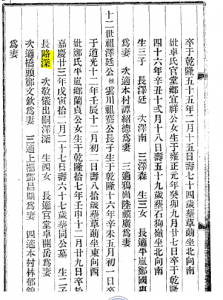
Gu Lue Shen in the 1948 Nazhou Gu Jiapu
They scanned the pages and sent it to her to use as a resource. To her delight she saw that this version had pristine, undamaged pages. She wrote, “There are 4 books of the jiapu. In book 2, I found your 3rd grandfather Gu Lue Shen’s name. There are over a hundred pages in book 2. I have checked their names in family search, and most of book 2’s names have not been entered in there by anyone yet.” Here is Gu Lue Shen in my family tree – complete with all the family information pulled from the jiapu.
Louise has put this treasure to good use. These precious records have been instrumental in building out the pedigree of many more of my Gu ancestors, as well as expanding the trees of other Goo/Gu descendant families who have found us.
Explore the 1948 Nazhou Gu Jiapu
You can see the four volumes of the 1948 Nazhou Gu Jiapu, and read the story of how it was heroically preserved.
Scenes of Nazhou
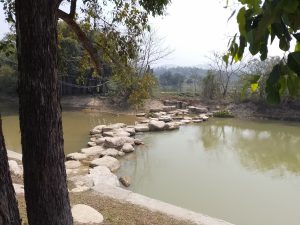
Nazhou River
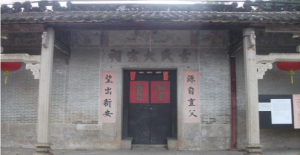
Gu Temple – Nazhou

Gu Temple Street – Nazhou
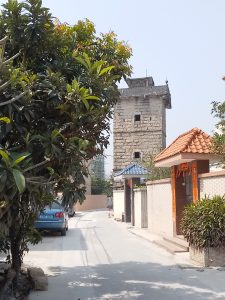
Nazhou-blockhouse-東村炮樓
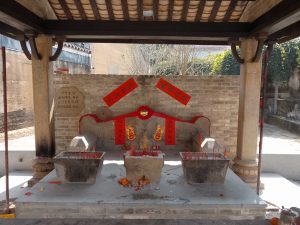
Nazhou-Earth-Gods-temple-那洲土地公廟神亭.jpg
